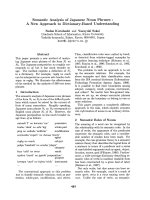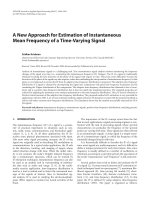A facile construction of the tricyclic 5 7 6 scaffold of fungi derived diterpenoids the rst total synthesisof (±) heptemerone g and a new approach to danishefsky s intermediate for a guanacastepene
Bạn đang xem bản rút gọn của tài liệu. Xem và tải ngay bản đầy đủ của tài liệu tại đây (412.78 KB, 3 trang )
Tetrahedron Letters 51 (2010) 4344–4346
Contents lists available at ScienceDirect
Tetrahedron Letters
journal homepage: www.elsevier.com/locate/tetlet
A facile construction of the tricyclic 5-7-6 scaffold of fungi-derived
diterpenoids. The first total synthesis of (±)-heptemerone G and a new
approach to Danishefsky’s intermediate for a guanacastepene A synthesis
Karol Michalak, Michał Michalak, Jerzy Wicha *
Institute of Organic Chemistry, Polish Academy of Sciences, ul. Kasprzaka 44/52, 01-224 Warsaw 42, Poland
a r t i c l e
i n f o
Article history:
Received 27 April 2010
Revised 27 May 2010
Accepted 11 June 2010
Available online 17 June 2010
a b s t r a c t
The first total synthesis of (±)-heptemerone G, a diterpenoid metabolite of a submerged culture Coprinus
heptemerus, and a new approach to an advanced intermediate for a synthesis of guanacastepene A are
reported.
Ó 2010 Elsevier Ltd. All rights reserved.
Keywords:
Annulation reactions
Medium-ring compounds
Quaternary stereocenters
Terpenoids
Total synthesis
Fungi-derived and microbial terpenoids, distinctive by the presence of medium rings in their structures, are important synthetic
targets.1 Recently, the attention of several groups has focused on
guanacastepenes, a family of diterpenoids isolated from endophilic
fungi growing on the branches of the Daphnopsis americana tree
(Guanacaste Conservation Area, Costa Rica).2 The first identified representative of this family, guanacastepene A (1, Fig. 1), has a tricyclic
structure with linearly fused five-, seven- and six-membered rings.
The ‘northern’ region of this molecule is highly polar while the opposite side is hydrophobic and bears two quaternary carbon atoms, and
an isopropyl group. More recently, structurally closely related terpenoids named heptemerones, including heptemerone G (2) were isolated from a broth of a submerged culture of Coprinus heptemerus.3
Interest in guanacastepene and heptemerone synthesis has
been stimulated by their fascinating structures and biological
activity. The crude fermentation extracts of fungi from Daphnopsis
as well as isolated guanacastepene A were found to be highly active against certain malicious antibiotic-resistant bacteria.2b
Although the biological activity profile of guanacastepene A is
encumbered with a detrimental side effect (lysis of human red
blood cells), a new class of structures has been revealed for chemical and pharmacological exploration.
The first total synthesis of guanacastepene A (1) was reported
by Danishefsky and co-workers.4 The synthesis of 1 has also been
accomplished by Shipe and Sorensen5 and formal total syntheses
were reported by Hanna,6 Snider,7 and Mehta et al.8 Guanacastepene C was synthesized by Mehta et al.,8 guanacastepene N by
Overman and co-workers,9 and guanacastepene E by Trauner and
co-workers.10 To date, only one representative of the heptemerone
family, heptemerone B, has been synthesized.10 Several approaches
to advanced intermediates for guanacastepene synthesis have also
been developed.11,12
15 H
O
O
4 OH
3
14 1
AcO
5
A
C
B
12
11 8
16
1
guanacastepene A
18
17
0040-4039/$ - see front matter Ó 2010 Elsevier Ltd. All rights reserved.
doi:10.1016/j.tetlet.2010.06.064
O
H
OAc
2
heptemerone G
O
O
O
3
* Corresponding author. Tel.: +48 22 632 8117; fax: +48 22 6326681.
E-mail address: (J. Wicha).
O
O
O O
Ot-Bu
O
4
Figure 1. Structures of guanacastepene A, heptemerone G and the key synthetic
intermediates.
4345
K. Michalak et al. / Tetrahedron Letters 51 (2010) 4344–4346
O
O O1 2 3 O
H
O OH
14
O O H
a)
O
6
O O
O
O O
O
15, X = H
16, X = SePh
14
t-BuO2C
3
b)
13
8
5
14
X
O O H
OTMS
c)
O
8
4
O O
d)
O O
O
e)
O
8
7
8
17
18
Scheme 1. Highlights of the proposed scheme for the synthesis of 4.
We now report the first total synthesis of heptemerone G (2)
and, en route, a new synthetic approach to compound 3 (which
is a guanacastepene A precursor in the Danishefsky synthesis),
via the versatile tricyclic intermediate 4.
The main features of the proposed synthetic route to 4 are
shown in Scheme 1. The bicyclic intermediate 5, readily prepared
from 2-methylcyclopent-2-en-1-one, allylmagnesium bromide,
and pivaloyloxymethyl vinyl ketone was the connection point to
our earlier work.13 It was envisioned that the hydroxy-epoxide
function in 5 will be used, after protection of the oxo group at C14, to install the oxo group at C-3 and the allyl group at C-8. The
intermediate 6 would then be dehydrogenated and the product
subjected to methylation to afford 7. Danishefsky4b,d and Mehta14
have shown that methylation of similar a,b-unsaturated ketones
introduces the methyl group in a trans-orientation with respect
to the angular methyl group. The allyl and oxo groups in the intermediate 7 were designed to serve as bridgeheads for forming ring C
via the keto-ester 8. Further transformations of 4 into 2 and 3 will
require diastereoselective reduction of the keto group (C-5) and
other functional group interconversions.
The alcohol 5,13a on treatment with p-tosyl chloride in pyridine,
gave the corresponding tosylate which, without purification, was
subjected to Finkelstein exchange and the resulting unstable iodide
9 (Scheme 2) was reduced immediately with zinc in absolute ethanol15 to give alkene 10. Careful acetylation of 10 with acetic anhydride and DMAP in dichloromethane gave the acetate 11
contaminated with (presumably) its cis-azulene epimer (10% by
1
H NMR). All attempts to protect the keto group in 10 or 11 by
reaction with ethylene glycol under standard conditions (acid catalyst, benzene, reflux with water removal) led to the formation of
mixtures of products. After considerable experimentation, we
found that treatment of a suspension of 11 in ethylene glycol with
Scheme 3. Construction of the required stereogenic center at C-8. Reagents and
conditions: (a) CH2@CHMgBr, CuI, HMPA, TMSCl, THF, À78 °C to rt, 30 min; (b)
Bu4NFÁ3H2O, THF, rt, 15 min, 92% from 13; (c) (1) LDA, THF, hexanes, À78 °C then
Me3SiCl, À78 °C to rt, (2) PhSeCl, CH2Cl2, Py, À78 °C to rt, 73%; (d) m-CPBA, NaHCO3,
CH2Cl2, À78 °C, 30 min and then Et3N, satd aq Na2SO3, rt, 20 h, 89%; (e) LHMDS, THF,
0 °C, 2 h and then HMPA, MeI, À20 °C, 1 h, 98%.
p-toluenesulfonic acid as the catalyst and methyl orthoformate as
the water scavenger, at room temperature, afforded the corresponding ethylene ketal. Hydrolysis of the crude ester then gave
the hydroxy-ketal 12. Manganese dioxide oxidation16 of 12 furnished the methylidene ketone 13 and the latter was used immediately in the next step.
Copper-assisted conjugate addition of vinylmagnesium bromide to enone 13 (Scheme 3) in the presence of TMSCl4d,17 gave
the silyl enol ether 14 which was subsequently treated with tetrabutylammonium fluoride to afford ketone 15 as a single epimer
(the configuration at C-8 is of no consequence for the synthesis).
The ‘kinetic’ lithium enolate was then generated from 15 using
LDA and trapped with TMSCl. The trimethylsilyl derivative was
then transformed18 into the phenylselenide 16 and subsequently
into the enone 17. The lithium enolate generated from 17 and
LHMDS was treated with an excess of methyl iodide in the presence of HMPA. A single product was obtained in 98% yield, which
was at least 99% pure by HPLC. The structure 18 was assigned to
this product.4d,7,14 Computational studies on the stereochemistry
of the methylation of 17 and its 1,2-dihydro-analog have been reported previously.19
O O
18
OTES
b)
a)
O O
OTES
R
O
O
H
O
OR
H
19
d)
b)
X
5, X = OH
9, X = I
O OH
20, R = CH 2OH
21, R = CHO
c)
t-BuO2C
a)
10, R = H
11, R = Ac
O OH
OH
c)
d)
O O
OH
OH
e)
O
8
f)
4
e)
22
12
13
Scheme 2. Synthesis of methylidene ketone 13. Reagents and conditions: (a) (1) pTsCl, pyridine, 0 °C, 6 h, (2) NaI, acetone, reflux, 20 min; (b) Zn, absolute EtOH,
reflux, 1 h, 92% from 5; (c) Ac2O, DMAP cat., CH2Cl2, rt, 89%; (d) (1) ethylene glycol,
p-TsOH cat., (MeO)3CH, rt; (2) KOH, MeOH, 96%; (e) MnO2, Et2O, rt, 84%.
Scheme 4. Synthesis of the tricyclic intermediate 4. Reagents and conditions: (a)
(1) NaBH4–CeCl3Á7H2O, MeOH, (2) Et3SiCl, imidazole, DMAP, CH2Cl2, 16 h, 90% from
18; (b) 9-BBN, THF, 0 °C to rt and then aq NaOH, H2O2, 0 °C to rt, 97%; (c) TPAP,
NMO, 4 Å MS, CH2Cl2, rt, 95%; (d) (1) CH3CO2t-Bu, LDA, THF, hexanes, À78 °C to rt,
(2) Bu4NFÁ3H2O, THF, rt, 0.5 h, 91% from 21; (e) Dess–Martin periodinane, NaHCO3,
CH2Cl2, rt, 15 min and then Na2SO3; (f) EtONa, EtOH, rt, 2.5 h, 80% from 22.
4346
K. Michalak et al. / Tetrahedron Letters 51 (2010) 4344–4346
O
a)
O O
OH
Ot-Bu
OH
5
O
H
OH
O O
c)
b)
OR
O O
e)
2
4
23
24
f)
25, R = H
26, R = Ac
d)
3
Scheme 5. Transformations of the core carbocyclic systems. Reagents and conditions: (a) LiAlH4, THF, À93 °C, chromatography, 77%; (b) LiAlH4, THF, rt, 0.5 h; (c) PhI(OAc)2,
TEMPO, CH2Cl2, rt, 60–70% from 23; (d) Ac2O, DMAP, Et3N, CH2Cl2, rt; 94%; (e) acetone, PPTS (cat.), rt, 94%; (f) acetone, p-TSA, rt, 95%.
Ketone 18 was reduced applying the Luche protocol,20 and the
resulting alcohol was protected as its triethylsilyl ether to give 19
(Scheme 4). The terminal double bond in 19 was then subjected to
hydroboration–oxidation to afford alcohol 20. Oxidation of 20 with
tetra-n-propylammonium perruthenate (TPAP)–NMO21 gave the
aldehyde 21. Addition of lithium tert-butyl acetate22 (generated
from tert-butyl acetate and LDA in THF at À78 °C) to 21 afforded an
adduct that was desilylated without purification. The mixture of
diols 22 so obtained was oxidized with freshly prepared Dess–Martin periodinane23 to give dione 8 that decomposed on attempted isolation. However, when crude 8 was treated with sodium ethoxide in
absolute ethanol, the tricyclic derivative 4 was formed smoothly
(80% yield from diol 22). It was pleasing to obtain this intermediate
as beautiful crystals (mp 145–146 °C, hexane), after struggling
through several stages with unstable oily intermediates.
The keto group in keto-ester 4 could be reduced selectively
using several reducing agents to afford a readily separable mixture
of alcohol 23 (Scheme 5) and its 5a-epimer. Lithium aluminum hydride in THF at -93 °C was the most favorable providing 23 in 77%
yield (6.5:1 isomer ratio).
The hydroxy ester 23 was further reduced with LiAlH4 at room
temperature into the diol 24 which was oxidized selectively with
PhI(OAc)2-TEMPO (2,2,6,6-tetramethyl-1-pyridinyloxyl) following
the procedure developed by Danishefsky et al. for a related diol.4d,24
The hydroxy-aldehyde 25 obtained in 60–70% yield was acetylated
with acetic anhydride in the presence of DMAP and triethylamine
to give acetate 26. Finally, removal of the ketal protecting group
afforded heptemerone G (2). The HRMS, 1H NMR (500 MHz, CDCl3),
IR and UV spectra confirmed the structure. The 1H NMR spectrum
(500 MHz) in DMSO-d6 at 100 °C showed signals in full agreement
with the reported data for heptemerone G.3a Interestingly, the synthetic material showed well-resolved signals in the 1H NMR spectrum at room temperature.25 However, broadening of some signals
was observed in its 13C NMR spectrum, presumably due to the conformational flexibility of this compound.2a,3a No spectrum of the natural compound was available for a direct comparison.
To complete the formal synthesis of guanacastepene A (1), diol
24 was dissolved in acetone and treated with a catalytic amount of
p-toluenesulfonic acid. Compound 3 was obtained (crystalline solid, 95% yield) showing the expected HRMS spectrum and 1H, and
13
C NMR spectra (500 and 125 MHz, respectively) in agreement
with the reported spectra.4d
In summary, a versatile intermediate 4 for the synthesis of tricyclic 5-7-6 diterpenoids has been synthesized from 2-methylcyclopent-2-en-1-one in thirty three steps and in a 5.2% overall
yield. This intermediate was employed in the first total synthesis
of (±)-heptemerone G (2) and in a synthesis of the (±)-guanacastepene precursor 3. Key features of the synthesis include an efficient
new synthetic sequence for annulation of the 2-methylcyclopent2-en-1-one fragment, an early introduction of the keto group at
C-14, a Wharton-type reduction of hydroxy-epoxide 5 into the
allylic alcohol 10, protection of enolizable ketone 11 under mild
conditions and a diastereoselective alkylation of the ‘kinetic’ enolate generated from 17.
Acknowledgment
Financial support from the Ministry of Science and Higher Education (Grant No. NN 204123937) is gratefully acknowledged.
Supplementary data
Supplementary data associated with this article can be found, in
the online version, at doi:10.1016/j.tetlet.2010.06.064.
References and notes
1. (a) Brase, S.; Encinas, A.; Keck, J.; Nising, C. F. Chem. Rev. 2009, 109, 3903–3990;
(b) Yet, L. Chem. Rev. 2000, 100, 2963–3007; (c) Petasis, N. A.; Patane, M. A.
Tetrahedron 1992, 48, 5757–5821.
2. (a) Brady, S. F.; Singh, M. P.; Janso, J. E.; Clardy, S. J. Am. Chem. Soc. 2000, 122,
2116–2117; (b) Singh, M. P.; Janso, J. E.; Luckman, S. W.; Brady, S. F.; Clardy, J.;
Greenstein, M.; Maiese, W. M. J. Antibiot. 2000, 53, 256–261.
3. (a) Valdivia, C.; Kettering, M.; Anke, H.; Thines, E.; Sterner, O. Tetrahedron 2005,
61, 9527–9532; (b) Kettering, M.; Valdivia, C.; Sterner, O.; Anke, H.; Thines, E. J.
Antibiot. 2005, 58, 390–396.
4. (a) Dudley, G. B.; Danishefsky, S. J. Org. Lett. 2001, 3, 2399–2402; (b) Tan, D. S.;
Dudley, G. B.; Danishefsky, S. J. Angew. Chem., Int. Ed. 2002, 41, 2185–2188; (c)
Lin, S. N.; Dudley, G. B.; Tan, D. S.; Danishefsky, S. J. Angew. Chem., Int. Ed. 2002,
41, 2188–2191; (d) Mandal, M.; Yun, H. D.; Dudley, G. B.; Lin, S. N.; Tan, D. S.;
Danishefsky, S. J. J. Org. Chem. 2005, 70, 10619–10637.
5. Shipe, W. D.; Sorensen, E. J. J. Am. Chem. Soc. 2006, 128, 7025–7035.
6. Boyer, F. D.; Hanna, I. Tetrahedron Lett. 2002, 43, 7469–7472.
7. Shi, B.; Hawryluk, N. A.; Snider, B. B. J. Org. Chem. 2003, 68, 1030–1042.
8. Mehta, G.; Pallavi, K.; Umarye, J. D. Chem. Commun. 2005, 4456–4458.
9. Iimura, S.; Overman, L. E.; Paulini, R.; Zakarian, A. J. Am. Chem. Soc. 2006, 128,
13095–13101.
10. Miller, A. K.; Hughes, C. C.; Kennedy-Smith, J. J.; Gradl, S. N.; Trauner, D. J. Am.
Chem. Soc. 2006, 128, 17057–17062.
11. (a) Fang, X. J.; Tong, X. F. Tetrahedron Lett. 2010, 51, 317–320; (b) Hashimoto, T.;
Naganawa, Y.; Maruoka, K. J. Am. Chem. Soc. 2009, 131, 6614–6617; (c) Malik, C.
K.; Ghosh, S. Org. Lett. 2007, 9, 2537–2540; (d) McGowan, C. A.; Schmieder, A.
K.; Roberts, L.; Greaney, M. F. Org. Biomol. Chem. 2007, 5, 1522–1524.
12. Maifeld, S. V.; Lee, D. Synlett 2006, 1623–1644.
13. (a) Michalak, K.; Michalak, M.; Wicha, J. Tetrahedron Lett. 2008, 49, 6807–6809;
(b) Michalak, K.; Michalak, M.; Wicha, J. Molecules 2005, 10, 1084–1100.
14. Mehta, G.; Umarye, J. D.; Srinivas, K. Tetrahedron Lett. 2003, 44, 4233–4237.
15. (a) Logusch, E. W. Tetrahedron Lett. 1979, 20, 3365–3366; (b) Oikawa, Y.; Nishi,
T.; Yonemitsu, O. J. Chem. Soc., Perkin Trans. 1 1985, 7–17.
16. Attenburrow, J.; Cameron, A. F. B.; Chapman, J. H.; Evans, R. M.; Hems, B. A.;
Jansen, A. B. A.; Walker, T. J. Chem. Soc. 1952, 1094–1111.
17. Corey, E. J.; Boaz, N. W. Tetrahedron Lett. 1985, 26, 6019–6022.
18. (a) Sharpless, K. B.; Lauer, R. F.; Teranishi, A. Y. J. Am. Chem. Soc. 1973, 95, 6137–
6139; (b) Reich, H. J.; Renga, J. M.; Reich, I. L. J. Am. Chem. Soc. 1975, 97, 5434–
5447; (c) Ryu, I.; Murai, S.; Niwa, I.; Sonda, N. Synthesis 1977, 874–876.
19. Wang, H.; Michalak, K.; Michalak, M.; Jiménez-Osés, G.; Wicha, J.; Houk, K. N. J.
Org. Chem. 2010, 75, 762–766.
20. Luche, J.-L.; Rodriguez-Hahn, L.; Crabbe, P. Chem. Commun. 1978, 601–602.
21. Ley, S. V.; Norman, J.; Griffith, W. P.; Marsden, S. P. Synthesis 1994, 639–666.
22. Rathke, M. W.; Lindert, A. J. Am. Chem. Soc. 1971, 93, 2318–2320.
23. Dess, D. B.; Martin, J. C. J. Org. Chem. 1983, 48, 4155–4156.
24. De Mico, A.; Margarita, R.; Parlanti, L.; Vescovi, A.; Piancatelli, G. J. Org. Chem.
1997, 62, 6974–6977.
25. The spectra of compounds 2, 3, 4 and 23 are included in the Supplementary
data.









